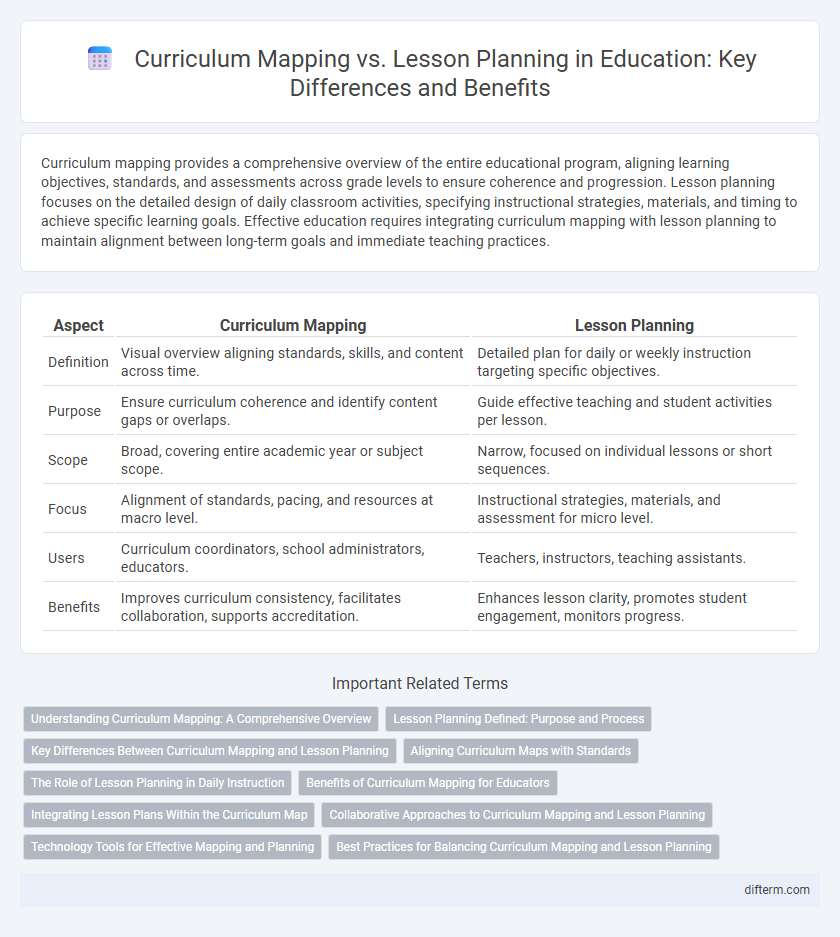Curriculum mapping provides a comprehensive overview of the entire educational program, aligning learning objectives, standards, and assessments across grade levels to ensure coherence and progression. Lesson planning focuses on the detailed design of daily classroom activities, specifying instructional strategies, materials, and timing to achieve specific learning goals. Effective education requires integrating curriculum mapping with lesson planning to maintain alignment between long-term goals and immediate teaching practices.
Table of Comparison
| Aspect | Curriculum Mapping | Lesson Planning |
|---|---|---|
| Definition | Visual overview aligning standards, skills, and content across time. | Detailed plan for daily or weekly instruction targeting specific objectives. |
| Purpose | Ensure curriculum coherence and identify content gaps or overlaps. | Guide effective teaching and student activities per lesson. |
| Scope | Broad, covering entire academic year or subject scope. | Narrow, focused on individual lessons or short sequences. |
| Focus | Alignment of standards, pacing, and resources at macro level. | Instructional strategies, materials, and assessment for micro level. |
| Users | Curriculum coordinators, school administrators, educators. | Teachers, instructors, teaching assistants. |
| Benefits | Improves curriculum consistency, facilitates collaboration, supports accreditation. | Enhances lesson clarity, promotes student engagement, monitors progress. |
Understanding Curriculum Mapping: A Comprehensive Overview
Curriculum mapping systematically aligns learning objectives, assessments, and instructional materials across grade levels to ensure coherent progression and coverage of standards. Unlike lesson planning, which focuses on day-to-day instructional activities, curriculum mapping provides a macro-level view of educational content and skills development over time. This comprehensive overview helps educators identify gaps, redundancies, and opportunities for interdisciplinary connections, promoting a more cohesive and effective learning experience.
Lesson Planning Defined: Purpose and Process
Lesson planning involves designing detailed instructional objectives, materials, and assessments to guide daily classroom activities and ensure curriculum alignment. It focuses on structuring individual lessons to meet specific learning outcomes while accommodating student needs and pacing. Effective lesson planning enhances instructional clarity, engagement, and assessment accuracy within the broader framework established by curriculum mapping.
Key Differences Between Curriculum Mapping and Lesson Planning
Curriculum mapping provides a broad overview of educational goals and standards across an entire course or academic year, ensuring alignment and coherence in content delivery. Lesson planning focuses on the detailed structure of individual classes, specifying objectives, activities, and assessments for daily instruction. While curriculum mapping guides long-term instructional strategies, lesson planning addresses immediate teaching needs and student engagement within a single lesson.
Aligning Curriculum Maps with Standards
Aligning curriculum maps with educational standards ensures coherent learning objectives across grade levels, enhancing student achievement and instructional consistency. Curriculum mapping systematically organizes content and skills by standard, enabling teachers to identify gaps and redundancies in the educational program. Lesson planning, in contrast, focuses on daily instructional activities, informed by the broader framework established through curriculum mapping aligned with standards.
The Role of Lesson Planning in Daily Instruction
Lesson planning serves as a critical component in daily instruction by providing structured guidance that aligns with curriculum mapping goals and standards. It ensures that each classroom session targets specific learning objectives, incorporates appropriate instructional strategies, and facilitates effective assessment methods. This organized approach enhances teacher preparedness, fosters student engagement, and supports consistent progress toward comprehensive educational outcomes.
Benefits of Curriculum Mapping for Educators
Curriculum mapping provides educators with a clear overview of instructional goals, ensuring alignment across grade levels and subjects for coherent student learning experiences. It facilitates identification of content gaps and redundancies, enabling targeted adjustments and improved resource allocation. Enhanced collaboration among teachers emerges as curriculum mapping encourages sharing best practices and promoting consistency in instructional delivery.
Integrating Lesson Plans Within the Curriculum Map
Curriculum mapping provides a comprehensive framework outlining the scope and sequence of educational content, while lesson planning focuses on detailed instructional activities and assessments. Integrating lesson plans within the curriculum map ensures alignment with learning objectives, standards, and pacing guides, enhancing coherence and instructional consistency. This practice supports targeted skill development, data-driven adjustments, and improved student outcomes across grade levels.
Collaborative Approaches to Curriculum Mapping and Lesson Planning
Collaborative curriculum mapping promotes shared ownership among educators by aligning learning objectives, standards, and assessments across grade levels, ensuring consistency and coherence in instruction. Joint lesson planning fosters real-time exchange of best practices, enables differentiation strategies tailored to diverse learners, and supports reflective teaching cycles. Integrating these collaborative approaches enhances curriculum transparency, professional learning communities, and student achievement outcomes.
Technology Tools for Effective Mapping and Planning
Technology tools for curriculum mapping like Atlas and Curriculum Trak enable educators to align standards, track progress, and visualize learning pathways effectively. In lesson planning, apps such as Planboard and Google Classroom streamline resource organization, facilitate collaboration, and personalize instruction. Integrating these digital platforms enhances coherence between curriculum mapping and daily lesson execution, improving overall educational outcomes.
Best Practices for Balancing Curriculum Mapping and Lesson Planning
Effective curriculum mapping aligns learning objectives with standards across grade levels, while detailed lesson planning translates these goals into daily instructional activities. Prioritizing collaboration among educators ensures consistency and coherence between long-term curriculum goals and short-term lesson execution. Utilizing digital tools enhances the integration of curriculum maps with lesson plans, promoting adaptability and ongoing assessment.
curriculum mapping vs lesson planning Infographic

 difterm.com
difterm.com